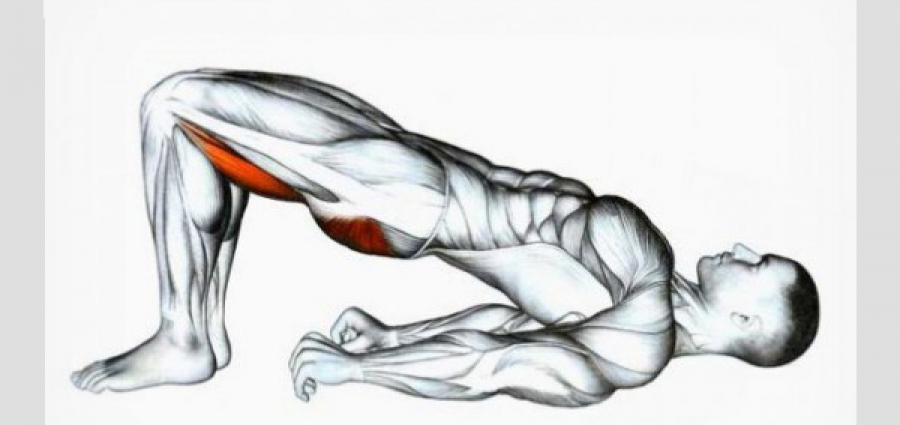Pelvic Raises or Glute Bridge is an effective multi-joint exercise that stretches the hips, tones the glute muscles, and makes them firm and lifted
Working Muscles
Primary muscles involved - gluteal (medium/large/small)
Secondary muscles – posterior chain of core muscles, posterior/anterior thigh muscles, spinal extensors, calves.
Content
Benefits and Application of the Glute Bridge
- Helps prevent and relieve back pain.
Exercise will be useful for both women and men.
For girls, a quick way to pump up the buttocks is very attractive, just by regularly and intensively performing pelvic lifts, this can be achieved.
.
- You will be able to improve your personal records in deadlift and squats
Deadlifts and squats actively engage the gluteal muscles. Weak and inactive gluteal muscles are unable to create sufficient tension in the thigh - this is the problem that many trainees face. The reason is the insufficiently effective interaction of the hips and the cortex. So the glute bridge can be considered another utility exercise for the deadlift. Therefore, by including pelvic lifts in your training, you can level the backlog of the gluteal muscles and, accordingly, improve the result in such important exercises as deadlifts and squats with a barbell..
- Lying pelvis raise will eliminate back and knee pain
Weakened by a lack of activity, the gluteal muscles are one of the causes of back pain. When the erector spinae and hamstring muscles take over the work that the gluteal muscles are supposed to do, what is called gluteal amnesia occurs. This leads to the fact that the load that the hips should take on is transferred to the lower back, which is not designed for this purpose. This results in back pain. By performing the glute bridge regularly, you can get rid of annoying back and knee pain, awaken the gluteal muscles and the pelvic region. This way, your body will remember to use your glutes to move, not your lower back.
One of the main causes of knee pain is the lack of control of the femur, which may twist slightly or move closer to the center of the body. These movements lead to pain in the knees. The gluteal muscles play an important role in the control of the femur at the hip joint, which affects the movement of other bones connected by the knee joint. The glute bridge (especially the one-leg version) will “teach” the femur to be in the correct position and relieve knee pain.
- Beauty and elasticity
Performing this exercise regularly, you will be able to qualitatively pump the gluteal muscles, tighten them, give them beauty and elasticity. For women, this is one of the best exercises for butt firmness and slimness.
Besides
When you do pelvic lifts, you get the following benefits:
- working out the buttocks without lack of pressure on the lower back (for example, with classic squats, the pressure is significant);
- buttock lift without using squats;
- strengthening the muscles of the press;
- the ability to perform the exercise both with your own and free weight;
- functionality - strengthening and increasing the strength of the muscles involved in running / jumping, etc.;
- improving the tone (blood circulation) of the pelvic organs and increasing libido;
- has an increased calorie consumption and helps in regulating body weight;
- Simplicity - no equipment needed, can be done at home.
Options
There are many options for performing a glute bridge, aimed at giving the gluteal muscles a beautiful shape, as well as strengthening them.
In addition to the classic performance of pelvic lifts, variations are also possible:
lifts with the weight of a pancake;
lifting from the bench;
lifts with one supporting leg;
barbell lifts.
Glute bridge technique with weight
- take a starting position, put weight on the press area, let it be a disk from the bar
- on exhalation, we lift the pelvis to the highest possible upper position
- at the top point of the trajectory, linger for 1-2 counts and perform a peak contraction, squeezing the buttocks;
- thus we carry out the planned number of repetitions
Common Mistakes:
Do not make too big / small angle between the lower leg and the back of the thigh, try to find the best supporting position for yourself with your feet;
Do not take your feet off the floor;
Don't stay at the bottom for too long;
Too much working weight. Carry out a smooth progression of loads, gradually increasing the weight of the burden;
More tips
Push with accentuated heels;
Try to tear the body off the floor as high as possible;
Do not lean your neck on the floor and do not pinch the nerve endings;
Conclusions
Here is a simple but useful exercise. Try to include it in your workouts at the very end of leg training or as a utility after the main base. Be sure to use additional weights.
Useful links
https://www.youtube.com/watch?v=0od5lwWMGV8



